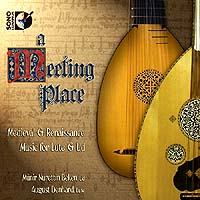

Sono Luminus
DSL-92133
Medieval & Renaissance Music for Lute & Ud
Münir Nurettin Beken, Ud
August Denhard, Lute

Separated by cultures, continents, and centuries of parallel development, the Turkish ud and Western European lute speak different languages today, yet they hearken back to a common origin. With the Sono Luminus release of A Meeting Place: Medieval & Renaissance Music for Lute & Ud, Münir Nurettin Beken and August Denhard explore the improvisatory richness of a performance tradition that their instruments may have shared in the Middle Ages and Renaissance.
Throughout its long history, the Turkish ud has been played primarily with a plectrum, a technique perfectly suited to the melodically colorful and sometimes rhythmically intense music of Turkey, the Arab countries, and Northern Africa. Moorish musicians brought the instrument to Spain, and Europeans may also have encountered it on the Crusades of the 13th century. As the ud developed into its European counterpart, the lute, it retained the plectrum, concentrating on single melodic lines. But lute players began to set the plectrum aside as later medieval music developed in polyphonic complexity. Fingers striking strings simultaneously could more easily imitate the two–, three–, and four–part textures of the emerging vocal style. For this recording, plectrum and finger techniques are used on both instruments as the artists explore the many roles that plucked instruments may have played in the medieval and renaissance periods.
|
1. Greensleeves - Anonymous (16th century) 2.12 2. Piva - Joanambrosio Dalza (fl.1508) 2.33 3. Estampie Fragment - anonymous in Robertsbridge Codex (c. 1360) 1.39 4. Recercada I - Diego Ortiz (c. 1515-60) 2.23 5. Nota I - anonymous in British Lib. Harley 978 (13th century) 1.35 6. Estampie - anonymous in Robertsbridge 3.36 7. Estampie IV - anonymous in Chansonnier du Roi (13th century) 3.12 8. Lamento da Tristano, Rotta - anonymous in British Lib. 29987 (c. 1400) 2.45 9. Spagna for two lutes - Francesco Canova da Milano (1497-1543) 2.45 10. Aspire refus contre doulce priere - Jacopo da Bologna (fl. 1340), Faenza Codex (15th century) 4.17 11. Notas II and III - anonymous in British Lib. Harley 978 2.12 12. La Manfredina Estampie - anonymous in British Lib. 29987 1.06 13. Douce Dame Jolie - Guillaume de Machaut (ca. 1300-77) 3.32 14. Belle Fiore Dansa - anonymous in Faenza 2.36 15. Untitled - anonymous in Faenza 1.35 16. Un fiore gentile m'apparse - Antonio Zacara da Teramo (fl. 1390), Faenza 2.18 17. Calata ala Spagnola - Joanambrosio Dalza 1.59 18. Saltarello - anonymous in British Lib. 29987 1.29 19. Buselik Saz Semaisi - Mutlu Torun (1972) 6.16 Total Time 49.55 |
Dorian Recordings & Dorian Discovery
are distributed in Australia by Rockian Trading